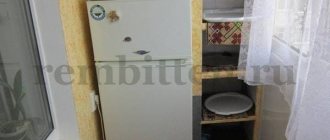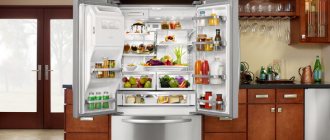When planning an apartment, the question often arises: is it possible to place a refrigerator next to a heating radiator?
This is a difficult matter that needs to be carefully considered and several nuances resolved. A large kitchen is a rarity that is not available to everyone. In addition to proper placement and redevelopment, it is important to remember the small free space that is necessary for movement.
All owners of small kitchens face the problem of placing a refrigerator. The location for the refrigeration equipment must be chosen in advance and taken care of as well. In the vast majority of cases, placing it next to the radiator is the only possible and acceptable solution. Let's consider the subtleties and nuances of this issue.
The refrigerator is the largest appliance in the kitchen, but you can’t do without it. The owners can only place it in the corners where the battery is located, however, this must be done taking into account certain rules so as not to damage the equipment.
Features of placing a refrigerator next to a radiator
Many people are interested in the question: why can’t you tolerate the proximity and place the refrigerator next to the radiator? There must be a protective barrier, which can be a simple plywood sheet, on top of which is a sheet of foil that reflects heat.
Many owners of small kitchens decide to use the space near the windowsill, although the exception is the refrigerator. Avoid exposure to direct sunlight.
It should not be installed in direct sunlight; it is important that the equipment is kept away from all devices with natural grounding, as this is not suitable for safety reasons. If there are no options, you need to fence it with a small wooden lattice.
Refrigerator Installation Methods
Before purchasing a useful kitchen unit, you should find out whether it is possible to place the refrigerator next to the radiator on its side or back wall. Its performance depends on the correct location of the device.
In large kitchens, this unit is installed in a kitchen cabinet system. The device is separated from the stove or battery by several meters. In a small kitchen, the refrigerator is isolated from heating appliances in different ways.
It is important to know! “Wherever you decide to place the refrigerator, it should be installed at a distance of 5 cm from the wall or any other surface. This rule applies to both the back wall and the side panels.”
The exception is those devices in which the fan and compressor are located at the bottom. They can be installed flush against walls and cabinets.
Is it possible to place a refrigerator next to a radiator?
This type of placement of equipment is strictly prohibited.
Experts do not recommend placing a cooling unit next to a heating source, as this can lead to a number of problems. First of all, electricity consumption will increase. It is recommended to study the instructions, which describe problems that arise from improper use. To extend its service life, it is better to choose another room for placement.
Is it possible to place a refrigerator next to the battery: at what distance
At what distance from the battery can a refrigerator be placed? This is a question that often arises in different situations. The design of a modern kitchen and the location of the refrigerator are closely interrelated. You should also take into account the minimum permissible distance from the radiator to the refrigerator. The installation of a far from cheap unit should occupy the most important place in determining the location of kitchen attributes.
What to do if there is no other way out
Make a distance from the battery to the refrigerator of at least 50-60 cm.
There are often situations when the room is simply catastrophically small, so it is simply impossible to install a refrigerator in another place, you have to look for alternatives. The only way is near a heating device, battery or radiator. You shouldn’t be upset, because there are certain conditions under which such an installation is still allowed. The main thing is to adhere to the following recommendations:
- the rear wall must be at a certain distance from the battery; it must be installed slightly sideways or on one side. This is the only way to avoid serious overheating and the refrigerator will not be broken;
- from a battery, the refrigeration device can be located no less than 60 cm from the heating surface;
- between the heat source and the cold surface, a special partition must be installed, the surface of which is foil-covered - thus, heat is reflected.
You can also install a foil partition between the battery, as is often done when installing next to the stove.
It is strictly prohibited to install the device closely! The motor, powered by electricity, and the battery cannot interact with each other, and it is difficult for the installation to tolerate the heat generated by the battery. If the motor fails, the technician will not undertake to repair it - this case is considered not subject to warranty.
A stylish solution is a protective box, which is often used as a design solution. But for this option there must be extra space.
There is an extreme option for placing and insulating the pipe, but this method is not always suitable - it is not possible to thermally insulate the pipe with special materials, since the specific arrangement of furniture, the layout of the room and its size do not always allow.
It is worth warning right away that damage due to improper placement of equipment is not subject to warranty.
Is it possible to place a refrigerator next to the radiator?
A standard heating radiator gets so hot in winter that it can melt plastic. Therefore, placing a cooling cabinet next to it is prohibited. The walls of the unit should not come into contact with heating devices.
Advice! “Do not place a cooling cabinet near heating appliances or a stove. The distance from the unit to the heating surfaces must be at least 50 cm.”
If the only installation option is a place near the radiator, you can place the refrigerator in another room, in the pantry, in the hallway. During the winter months, leaving the heating on will certainly negatively affect the operation of the cooling unit.
You may be interested in: Refrigerator next to the stove in the kitchen
Location standards
According to technical standards, the distance from various systems and walls to the refrigerator should be as follows:
- from the radiator or hot water pipe to any wall of the unit - 50 cm;
- from the side wall of the device to the battery – 30 cm;
- from the back wall to the heating device - 0 cm.
There is a complete ban on installing refrigeration equipment with a rear wall to heating systems. The same rules apply for the stove as for the battery.
Distance to system
Any side of the refrigeration equipment should be 50 cm away from the heating systems. This distance is enough to prevent the harmful effect of heat on the cooling unit.
If there is a heating pipe running under the floor of the house, or a “Warm Floor” system is installed in the home, a place for the refrigerator is chosen on the loggia, or a place for it is determined in advance before the renovation, where the heating will not be turned on at all.
Rules for installing a refrigerator
It is not recommended to install refrigeration equipment close to a heating source. Even if you have very good thermal insulation, the cooling system may not work smoothly, and the condenser cooling may malfunction and fail. Also, you should not place the unit near a window that faces south - it quickly overheats in the sun.
No matter how much you want to maximize space, leave space on all sides of the refrigerator.
If you often open the door and look inside, you must adhere to a certain level of humidity - plant products should be stored at 95%, animal products - only 70%.
Do not place the refrigerator near the stove under any circumstances; the consequences may be the same as when installed next to the battery.
If the refrigerator is placed on a balcony that is not heated, nothing good will come of it, because the temperature in the room directly depends on the type of refrigerant in a particular model. Some types begin to thicken, leading to breakage. It is important to remember the gaps between the walls and the unit. The electrical supply must be grounded and must be safe.
Is it possible or not?
When planning the placement of household technical devices in the kitchen, consumers are interested in whether it is possible to place a refrigerator next to a heating radiator. Devices overheat when placed close to a radiator. Therefore, experts recommend placing equipment away from heating devices to prevent breakdowns.
When located near the battery, the back wall of the refrigerator will heat up excessively, increasing the consumption of electrical energy to maintain a stable temperature of the unit.
Therefore, the instructions indicate the need to locate refrigeration equipment from the batteries at a sufficient distance.
Protection from harmful heat
How to protect a refrigerator from the effects of a radiator? The basic rule is to remember the gap between the equipment and the stove (no matter electric or gas). It must be at least 30 cm, this is the only way to guarantee that everything will be in perfect order.
You can make an indent from the stove, and use the resulting space as storage space
But there are nuances - even such a distance cannot solve the problem of splashes while eating or preparing food. Therefore, it is important to choose a more suitable option - wipe everything at once or cover the surface. One of the simplest solutions is a foil flap, which is attached to simple magnets or special hooks.
You can make a special cabinet for the refrigerator that will protect it from heat and splashes while cooking. Only here it is worth remembering that indentations must also be observed inside.
Many people use PPC film, but this is not always appropriate - this coating negatively tolerates heat, temperature changes and temperature fluctuations (this is important to consider, since splashes during cooking can be too hot).
The proximity of the stove and refrigeration equipment must be blocked with a certain amount of insulation - there are no special devices, there is only the possibility of using something at hand.
If you order the entire set as a set, then it is best to ask the designer to select the most suitable solution.
What materials are used to create partitions:
- Foam plastic, chipboard, reeds are occasionally used. The ideal option is a cork slab. There is a minus - high cost.
- Organic materials have advantages - they are resistant to moisture and do not absorb odor. Among the disadvantages is that they can melt and are subject to deformation. If we talk about inorganic materials, we can highlight asbestos cardboard, fiberglass, and drywall. They are non-flammable, inexpensive, but can lose their properties under the influence of moisture (not counting fiberglass).
Under what conditions can you place a refrigerator next to a radiator?
According to the instructions, placing the refrigerator near heating appliances is strictly prohibited. The distance between them should be no less than 40 centimeters. There is a big caveat - this option is not suitable for kitchens with a small area. If it turns out that you need to move the unit closer to the radiator, it will have to be isolated as much as possible from the installation.
If you create a partition yourself, then use not ordinary foil, but special high-temperature insulating foil.
It is recommended to create a special partition from plywood or other suitable material that can be covered with aluminum foil. Plastic or drywall work well.
It is desirable that this shield has a small layer.
This shield must be placed between the radiator and the refrigeration unit to reflect thermal radiation. If there is such a possibility, it must be placed sideways, half of the body, so that it covers the battery, and the gap between them is at least 5 cm - this is important for the circulation of air masses and the flow of air for cooling.
Reasons why you should not place a refrigerator next to a radiator
Cold and heat don't go well together. In this case, it is the refrigerator that will suffer.
Such problems are possible.
- Increased energy consumption. Such devices are designed in such a way that the motor does not run all the time, but turns on periodically to maintain a certain temperature. Then it turns off again. If the unit is placed near the battery, the temperature rises faster, which means the motor turns on more often.
- It is worth knowing that refrigerators produced for different climatic conditions differ in their climate class. It depends on the extreme temperatures. For example, equipment for hot countries has improved thermal insulation, which keeps the temperature in the chamber longer. If a refrigerator intended for middle latitudes is located next to the battery, then the operating conditions are violated. The compressor works almost without interruption and fails faster.
- In some cases, a refrigerator located next to a heating device does not have enough power to maintain normal temperatures in the refrigerator and freezer compartments. Then the products are unlikely to be stored for a long time.
If the refrigerator located near the battery breaks down, it will not be repaired under warranty, because the operating conditions were violated. So repairs will not be cheap.
Distance between refrigerator and battery
Air circulation is one of the most important aspects in the operation of a refrigerator if it is installed in a thermal accessibility zone. There should be a distance from the ceiling to the device of at least 30 cm, from the wall to the back of the case - 5 - 10 centimeters. The distance from the floor covering to the bottom of the equipment is at least 4 cm, and between the wall and the heating device is about 40 cm. Exactly the same distance must be maintained between the equipment and the radiator.
Even if a partition is used, the distance between objects must be maintained.
The legs of the refrigerator can be adjusted in height, you can conveniently adjust the position of the unit if the floor is uneven, adjust the gap between the bottom and the floor so that there is an air cushion and air can pass through. If there are heating pipes near the installation site, it is recommended to insulate it using a special permissible material.
Consequences of placing a refrigerator next to a battery
The refrigerator motor can overheat and burn out if you place it next to the battery.
The refrigerator is a large insulated cabinet, inside of which refrigerant flows through tubes, due to which food freezes. On the rear panel there is a radiator and a compressor responsible for cooling the liquid carrier. The motor is located in a container and cools due to the constant flow of liquid from the internal chamber. To prevent the working parts from overheating, a technological gap is provided between the rear wall of the refrigerator and the adjacent surface, amounting to 8-10 cm for different models.
If you install a refrigerator near a battery, the consequences may be as follows:
- The compressor will work constantly as it begins to heat up from the radiator. Hot air prevents the engine from cooling, causing it to burn out.
- The heat sink will not be able to remove the heat produced by the equipment. To achieve the set temperature in the chamber, the engine will work at maximum load, which will lead to increased energy consumption.
- Since the batteries are installed in a niche under the window, there will be problems with access to its sashes. In addition, part of the window opening will be closed, which will make the room darker. This will also have a negative impact on the interior, where the window sill, curtains and street landscape play an important role.
- Reducing the air temperature in the kitchen. Since the refrigerator will obscure part or all of the radiator, its heat will be blocked, and the heated air will rise to the ceiling.
- Ice formation in the freezer. This happens when the equipment is positioned with the side wall facing the heater. The result is spoilage of products and loss of their presentation. The freezer will need to be cleaned more often, as the mass of ice deforms the tubes.
The idea of installing a refrigerator near a battery is a loser in every way. Expensive equipment can become unusable literally in a matter of days. Free repairs under warranty will be refused, since all manufacturers indicate in their operating instructions that it is inadmissible to place refrigerators near heating devices.
Alternative options
A suitable option is a storage room, which is often cluttered with unnecessary things and supplies, and is used as a spacious closet. A method that only at first glance seems inconvenient. If the kitchen is small or close to the heating unit, place the refrigeration equipment in a separate room.
A good option is a loggia facing the kitchen, but there is one main condition - the presence of heating and a glassed-in room.The small parameters of the apartment force us to introduce a second good option - install equipment in the hallway, because there are often niches in which cabinets and shelves are placed. And if the kitchen is next to the hallway, you won’t have to go far.
Another way out is to move the equipment to the hall, but this is a personal decision of the apartment owners - after all, the hall is considered a recreation area. But if there is a question about long-term use, it is easier to choose the option that suits you. If you live in a Khrushchev-era building, then the living room is a relatively good option - you can make a small niche into which the refrigerator will fit.Is it worth the risk?
It's no secret that heat and cold are incompatible factors. If the refrigerator is located in close proximity to the battery, there is a risk that the energy consumption of the unit will increase significantly. In addition, being near heating devices can lead to equipment breakdown. Therefore, manufacturers do not recommend placing these things next to each other.
There is often a situation where it is possible to place the refrigerator only near the radiator. According to experts, if you do not take care of safety measures in this case, sooner or later the equipment will simply fail. This occurs due to the fact that when located close, the heater heats the rear surface of the unit, which is responsible for evaporating cold air.
To maintain its optimal temperature, the refrigerator will increase its electricity consumption, and over time this will negatively affect its operation. It is worth carefully studying the instructions, which clearly state the impossibility of installing units near heating devices.
If it is not possible to place the refrigerator away from the heating radiator, experts recommend not placing it in the kitchen at all. This condition will extend the life of the device and help free up kitchen space.
This is interesting: How to wash a leather jacket: effective ways to clean it at home
Important nuances when planning a kitchen
In order to create a comfortable environment in the kitchen, design experts advise using the win-win “triangle” rule. All kitchen equipment should be installed in 3 corners of the room; the most suitable option is to connect a gas stove, a dishwasher and refrigeration equipment.
This placement of all elements is the most successful. In addition to safety, it creates a comfortable space for work.
In this way, you can create an overall comfortable multifunctional complex, which is equipped with the necessary work surfaces, cabinets, and shelves.
Additional tips and advice
Use more built-in appliances, which is great for small kitchens.
If the size of the room does not allow for acceleration, it may be better to buy free-standing units, it will be more convenient and you can save free space. A good option is equipment that is built-in, allowing convenient placement and operation.










